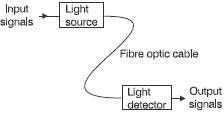Книга: Introduction to Microprocessors and Microcontrollers
An optic fibre link
An optic fibre link
A piece of optic fibre is a solid piece of glass or plastic. The plastic fibre is about 1 mm in diameter and is suitable only for short ranges of a few tens of metres but it has the advantage of being cheap and easy to use. Its useful range is limited by the clarity of current plastics. The special silica glass is incredibly clear and hence has much lower losses and able to be used over any distance, with suitable repeaters. It also has a much smaller diameter – only about 125 ?m before the external protective layers are added.
If a light is shone into the end of an optic fibre, it will reflect off the inner surfaces along the cable. The light source used is a laser operating in the infrared region of the spectrum. To use it as a means of sending a digital signal we need to switch the light source on and off and then detect the flashes of light at the far end of the cable by a photoelectric cell. The losses can be made up by repeaters just as we do on copper-based systems, so range of operation is no problem. The optic fibre does not suffer from any electric noise pickup along the route and has an enormous bandwidth. In one sense, it is not really optional because nearly all long distance telephone cables are now optic fibres. (See Further reading for our companion volume An Introduction to Fiber Optics.)
If we are constructing our own fibre optic link, all we need to do is to buy the laser (or light emitting diodes (LEDs)) and the photocells and some plugs and sockets to connect it all up. It can be used to replace the copper cable in any of the systems described (see Figure 17.14). Careful! The infrared light from the lasers can cause immediate and irreversible eye damage. We must always remember that we are down to our last pair of eyes.

Figure 17.14 A fibre optic link – any distance
Data transfer rates
Using a single optic fibre for serial transmission, typical data transfer rates of 100 Mbytes/s are available up to 10 km. Very high speed data transfer of 1 Gbyte/s can be achieved up to 100 m using parallel transmission along a bunch of fibre optic cables.
- Appendix E. Other resources and links
- 4.1 Сферы применения технологии Fibre Channel
- 4.3 Преимущества Fibre Channel
- 4.4 Топологии Fibre Channel
- 4.5 Типы портов Fibre Channel
- 4.6 Протокол Fibre Channel
- 4.8 Методы управления Fibre Channel
- 4.9 Обеспечение взаимодействия устройств Fibre Channel
- 2.3 Executable and Linking Format
- Свойство HelpLink
- Creating Links Between Files with ln
- 13.6.6. prelink




